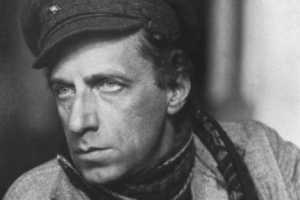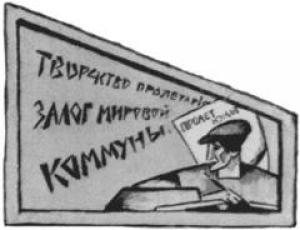
Spotlights and Searchlights: Theatre and the Russian Revolution
In a tribute to Russia’s theatrical experimenters, for whom the Revolution promised a new world of artistic possibilities, Amy Skinner presents a brief history of an art that 'without doubt, changed the world'.
On 25th February 1917, Revolution hung in the air of Russia’s capital city. The protests at the Pulitov Steel Works were gaining momentum, and gunshots had already been fired on Petrograd’s streets. Against this backdrop, unlikely though it may seem, the city’s theatres opened that evening as usual. At the Alexandrinsky Imperial Theatre, the audience, dressed in their evening wear, dodged bullets as they ran across Ostrovsky Square. The production that night was a premiere: the opening of director Vsevolod Meyerhold’s version of the Russian classic, Masquerade.
Meyerhold had worked on Masquerade for seven years: that the production opened on the same night that the February Revolution broke out was a coincidence; that the audience still braved the streets speaks, perhaps, to the centrality of theatre in Russian culture. From a long history of folk performance to the social conscience of the newly-formed Moscow Art Theatre, by 1917, theatre was emerging as a vital touchstone in Russian culture: an art form that was deeply and profoundly connected to real life.

And so came the audience to Masquerade, despite the risks inherent in crossing a city on the verge of uprising. On stage, they witnessed a spectacle of huge sets, elaborate costumes, and a cast of over 200 performers. Critics would scorn Meyerhold’s work for its decadence in the face of Revolution. It was certainly true that, as Meyerhold’s production played on stage that night, the world for which it had been created was disappearing outside the theatre’s doors. Within a matter of months, Russian politics would change beyond recognition and the expectation was that Russian theatre – valued as it was – would need to follow suit.
October in the Theatre
The new Bolshevik government was emphatic in its pursuit of theatre makers. In a country of Russia’s scale, with a largely illiterate population outside of the cities and poor communication systems, theatre offered the Bolsheviks a vital tool for spreading both news and ideology. It is fair to note, however, that the theatre makers’ initial response to Soviet overtures was not overwhelmingly positive. Many established companies wanted to give the new regime some time before committing their support. Others, particularly at the Imperial theatres, were more hostile: at the Maly, Lev Prozorovsky claimed that many actors ‘found themselves utterly confused. … They did not know and did not wish to know […] the Bolsheviks’ (in Rudnitsky, 2000, p. 47).
In November 1917, the theatres were nationalized and Anatoly Lunacharsky, as Commissar for Education, made the Bolshevik pursuit of the arts explicit by inviting 120 leading creative figures to meet for a discussion on the relationship between art and Communism. Only five attended; amongst them – and the only representative of the professional theatre – was Meyerhold. The Bolshevik’s choices were clearly limited, but Meyerhold was subsequently invited to take up the role of Deputy Head at the Petrograd Branch of TEO, the Commissariat’s Theatre Department. Meyerhold’s aim was the destruction of the old to create a new theatre which responded to the new world of Soviet Russia, what he called an ‘October in the Theatre’. Writing in 1920 in the journal Vestnik teatr (Theatre Herald), he notes:
At the present time, there are two possible types of theatre:
1. The non-professional proletarian theatre, whose roots are in the culture of the new ruling class
2. The so-called professional theatre (in Braun, 2016, p. 205)
The former, Meyerhold observes, evidences a ‘craze for theatricalization’ spreading across the country. ‘There are reports’, he concludes, ‘of villages with as many as five theatres’ (in Braun, 2016, p. 205). This multiplication of theatres, and the public appetite for theatre making (amateur and professional), is also reflected in an article in Khodozhestvennaya zhizn (Artistic Life), published in 1919:
Everywhere, throughout the length and breadth of the Republic, there is an insatiable thirst for the theatre and for its stirring impressions, and this thirst is not only not diminishing, but is steadily gaining strength. Theatre has become a necessity for everyone (in Rudnitsky, 2000, p. 41).
The popularity of theatre soared after 1917, presenting established theatre makers with a challenge: how could Russian theatre meet the needs of the proletariat, and what form should the new, post-Revolutionary theatre take?
The Golden Age
If one word could be chosen to describe Russian theatre in the early Soviet years, it would undoubtedly have to be ‘diverse’. This diversity was often accompanied by bitter conflict and polemics, as Petr Kogan observed in 1921:
In no field of art has the October Revolution provoked such intense struggle as in the sphere of theatre. In crucial moments of this struggle the boundaries which divide the adversaries from each other have been sharply delineated (in Rudnitsky, 2000, p. 41).
The range of fiercely-defended theatrical approaches after 1917 was partly a response to necessity: the Bolsheviks were keen to have the support of theatre artists, but less able to offer guidance on the form that Soviet theatre should take. The energy of the theatre makers outstripped the government’s theoretical formulations on the nature of Soviet art, often leaving them playing catch-up as the new regime tried to consolidate its arts policy. The more pressing concern of fighting a Civil War meant that the form of Soviet theatre was, pragmatically, initially left to the theatre makers themselves. The result was a moment of unrivalled experimentation: what Michael Glenny calls a ‘Golden Age’ of Russian theatre, in which creative energy, political necessity and artistic experimentation led to the creation of some of the twentieth century’s most innovative theatre practice.
For the professional theatres, much innovation emerged from the challenges of negotiating a new audience, often with little theatre-going experience. In Meyerhold’s words:
The audience has changed so completely, that we, too, need to revise our opinions […] each spectator represents, as it were, Soviet Russia in microcosm (in Braun, 2016, p. 211).
As a result, Meyerhold’s theatre turned towards popular influences, tap dance and American jazz, Civil War battle reports read aloud from the stage, clowning, acrobatics, and games with the audience during the interval. A new approach to training actors, called biomechanics, was developed, rejecting psychologism in favour of physical dexterity.

Anti-illusionist stage from Vsevolod Meyerhold's production of Nikolay Gogol's Revizor (The Government Inspector), Moscow, 1926. Courtesy of the Society for Co-operation in Russian and Soviet Studies
Meyerhold’s theatre was not the only experimental hub: at his Kamerny Theatre, Alexander Tairov (Meyerhold’s self-styled nemesis) explored stylized movement based on ballet, cubist designs, and a repertoire influenced by Western playwrights (particularly Eugene O’Neill). The futurist poets, including Vladimir Mayakovsky, experimented with new styles of playwriting. Even the pre-Revolution stalwarts, protected from Meyerhold’s reformative zeal by Lunacharsky, created space for experimentation. Stanislavsky’s Moscow Art Theatre, whose highly-detailed approach to realistic staging had gained world renown, launched a series of smaller studio companies. Here, avant-garde heavyweights were nurtured, including Yevgeny Vakhtangov, whose astonishing Princess Turandot (1922) saw actors in evening wear introduce the play and then transform the stage into a far Eastern fairy-tale setting before the audience’s eyes.
Outside the walls of the professional theatres, performance spilled onto the streets. Mass spectacles - huge-scale performance events - took place under searchlights rather than spotlights. Championed by the organization Proletarskaya Kultura (Proletarian Culture, shortened to Proletkult), these spectacles featured participants numbering tens or hundreds of thousands. Nikolai Evreinov’s Storming of the Winter Palace (1921), a re-enactment of the events of October 1917, featured 10,000 performers and 100,000 spectators: significantly more people than were involved in the historical event itself.
The Proletkult’s aim was the rejection of all pre-Revolutionary theatre forms in favour of a new Russian culture led entirely by the Proletariat. The lines between actor and spectator were to be blurred, with the ultimate goal, as Konstantin Rudnitsky notes, of ‘turning spectators into actors’ (Rudnitsky, 2000, p. 45). In fact, this transgressing of boundaries was not just at the heart of the Proletkult’s philosophy, but central to much early Soviet theatre. The unification of stage and auditorium is one of the most striking and enduring legacies of Russia’s theatrical revolution, framing spectators not as consumers but as contributors to theatrical events.
The End of the Golden Age
One difference between theatre and other art forms is that censorship is only partially effective in controlling its content. In order for live performance to be censored it must first be viewed, and once it has taken place, that act of viewing cannot be undone. The particularly harsh control seen in Soviet theatre after the Golden Age perhaps reflects the potential danger which the government perceived in that same communicative power which first attracted them to the medium. The Proletkult was disbanded in 1920 by a statement written by Lenin and published in Pravda. The organization’s powerbase was considered too extensive to be allowed to continue. By the late 1920s, the era of experimental freedom was virtually at an end, and a much increased mode of censorship was introduced. In 1934, Socialist Realism was endorsed as the only legitimate style of Soviet Art, and the avant-garde experiments of 1920s Moscow and Petrograd were brought to an abrupt end. Meyerhold was arrested and executed for anti-government activity, Tairov’s theatre was closed, Stanislavsky was suffocated by over-enthusiastic state endorsement.
The Golden Age itself, however, remains one of the most vibrant and innovate periods in the history of theatre. The experiments carried out by the artists of the avant-garde would not look out of place in many of today’s performances. Russia’s influence spread throughout the theatre world, with directors from Bertolt Brecht to Katie Mitchell finding inspiration in the Soviet legacy. It seems fitting to give the last word to Meyerhold, the figure at the centre of early Soviet theatre innovation who ultimately paid for his experiments with his life, and whose description of the new Soviet theatre captures some of the energy and passion which characterised the work of this unique and game-changing theatrical moment:
Here is our theatrical programme: plenty of light, plenty of high spirits, plenty of grandeur, plenty of infectious enthusiasm, unlaboured creativity, the participation of the audience in the corporate creative act of the performance (in Braun, 2016, p. 211).
On the occasion of the anniversary of 1917, this article is written in tribute to Russia’s theatrical experimenters, for whom Revolution promised a new world of artistic possibilities, and whose work has, without a doubt, changed the world.
References
Braun, Edward. 2016. Meyerhold on Theatre (London and New York: Bloomsbury)
Braun, Edward. 1998. Meyerhold: A Revolution in Theatre (London: Methuen)
Glenny, Michael. 1981. The Golden Age of Soviet Theatre (Middlesex: Penguin Books)
Rudnitsky, Konstantin. 2000. Russian and Early Soviet Theatre: Tradition and the Avant-Garde, trans. R. Permar (London: Thames and Hudson)











